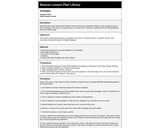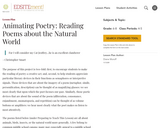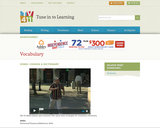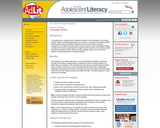
This resource from the New York Times includes a variety of lessons, ideas, and resources to teach students to new vocabulary.
- Provider:
- New York Times
- Author:
- NY Times Learning Network
- Date Added:
- 06/24/2019

This resource from the New York Times includes a variety of lessons, ideas, and resources to teach students to new vocabulary.

This resource accompanies our Rethink 7th Grade ELA course. It includes ideas for use, ways to support exceptional children, ways to extend learning, digital resources and tools, tips for supporting English Language Learners and students with visual and hearing impairments. There are also ideas for offline learning.

This parent guide supports parents in helping their child at home with the 7th grade ELA content.

There is no one poem that represents the experience of African Americans in the United States, yet the history of racism in this country is seared deeply into the lives of many African Americans. “The Weakness” by Toi Derricotte recounts an experience with racism through the eyes of a young, light-skinned African American girl going shopping with her grandmother in a department store in 1945. The poems in The African American Experience offer a number of perspectives from African American poets that add a rich complexity to students’ perceptions of African American lives.

Seven-year old Annie Dillard enjoys playing football with the boys in her neighborhood because it requires her to play with concentration and courage. In this CCSS lesson, students will explore this story through text dependent questions, academic vocabulary, and writing assignments.

In this lesson, students will learn about relationships between words and will then be expected to figure out the missing word for a list of analogies.

In this lesson, students will continue to analyze working conditions in the mill and how they affect Lyddie. This lesson adds a focus on word choice and figurative language, as students discuss how author Katherine Paterson’s choice of language helps the readers better understand Lyddie’s working conditions and how they affected her.

The purpose of this project is two-fold: first, to encourage students to make the reading of poetry a creative act; and, second, to help students appreciate particular literary devices in their functions as semaphores or interpretive signals. Those devices that are about the imagery of a poem (metaphor, simile, personification, description) can be thought of as magnifying glasses: we see most clearly that upon which the poet focuses our gaze. Similarly, those poetic devices that are about the sound of the poem (alliteration, consonance, enjambment, onomatopoeia, and repetition) can be thought of as volume buttons or amplifiers: we hear most clearly what the poet makes us listen to most attentively.

This is a poem about love that Poe has written in memory of his wife, whom he calls Annabel Lee. In this CCSS lesson, students will explore this story through text dependent questions, academic vocabulary, and writing assignments.

In this lesson, the students will read and reread the passage closely and focusing their reading through a series of questions and discussion about the text, students will be able to understand the structure and purpose of this particular soliloquy and how it delves into universal themes regarding the human condition.

In this CCSS lesson, students will explore this story through text dependent questions, academic vocabulary, and writing assignments. Printable text files included.

In The Bear Boy, a man does not teach his son the ways of Pueblo life and how to transition into manhood. In this CCSS lesson, students will explore this story through text dependent questions, academic vocabulary, and writing assignments.

Students use Shakespeare's Secret, a featured title on the Teachers' Choices Booklist (International Reading Association, 2006), as a springboard to exploration of the controversy regarding the authorship Shakespeare's works. The novel makes liberal use of the historical details surrounding William Shakespeare's life, and exposes students to the possibility raised by some theorists that Edward de Vere, Earl of Oxford, was the true author of the works that have long been attributed to the Bard. Students explore the historical references in the novel and generate questions for further research. As they research these questions on suggested websites, they organize their findings with the help of the ReadWriteThink Notetaker. Then they work in small groups to create and present short dramatic skits that creatively connect the novel with the historical facts.

Students become novice lexicographers as they explore recent new entries to the Oxford English Dictionary (OED), learn the process of writing entries for the OED, and write a new entry themselves. Students will follow up their entry with a persuasive essay and a competition in which the strongest contender for the title of New Word is chosen. Extensions will offer students a chance to evaluate old lists of "new words" and discuss the power dynamics of dictionaries.

In this lesson, students draw pictures to illustrate the meaning of the word and improve vocabulary skills.

In this CCSS lesson, students will explore this history through text dependent questions, academic vocabulary, and writing assignments.

A short video on choosing the correct dictionary for each student's needs.

A concept sort is a strategy used to introduce students to the vocabulary of a new topic or book. Teachers provide students with a list of terms or concepts from reading material. Students place words into different categories based on each word's meaning. Categories can be defined by the teacher or by the students. When used before reading, concept sorts provide an opportunity for a teacher to see what his or her students already know about the given content. When used after reading, teachers can assess their students' understanding of the concepts presented.

A series of worksheets with answer keys to help students of differing levels define unfamiliar vocabulary using context clues.

A collection of worksheets for various student levels to help define unfamiliar vocabulary in contextual readings. (Note: scroll down to bottom of page for worksheet links to grades 6-12.)